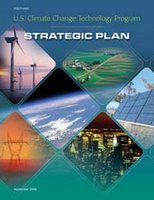U.S. D.O.E.: Strategies for Reducing Greenhouse Gases
 On September 21st the U.S. Department of Energy released their Climate Change Technology Program (CCTP) Strategic Plan which describes broadscope measures that the D.O.E. should pursue to reduce greenhouse gas emissions. The publication of the study confirms that the U.S. Department of Energy considers "climate change" to be a pressing issue:
On September 21st the U.S. Department of Energy released their Climate Change Technology Program (CCTP) Strategic Plan which describes broadscope measures that the D.O.E. should pursue to reduce greenhouse gas emissions. The publication of the study confirms that the U.S. Department of Energy considers "climate change" to be a pressing issue:
As a party to the United Nations Framework Convention on Climate Change (UNFCCC), the United States shares with many other countries the UNFCCC’s ultimate objective, that is, the “…stabilization of greenhouse gas concentrations in Earth’s atmosphere at a level that would prevent dangerous anthropogenic interference with the climate system . . . within a time-frame sufficient to allow ecosystems to adapt naturally to climate change, to ensure that food production is not threatened, and to enable economic development to proceed in a sustainable manner.” Meeting this objective will require a sustained, long-term commitment by all nations over many generations.
Technologies emphasized for development are hydrogen extraction, biorefining, renewable power generation, clean coal and carbon sequestration, nuclear fission and fusion. Of these, biomass conversion is applicable to all but nuclear fission and fusion.
Below are some excerpts that relate specifically to biomass conversion and syngas technologies:
-----------------
U.S. Climate Change Technology Program Strategic Plan
September 2006
The Plan sets six complementary goals:
1 - Reducing emissions from energy use and infrastructure;
2 - Reducing emissions from energy supply;
3 - Capturing and sequestering carbon dioxide;
4 - Reducing emissions of other greenhouse gases;
5 - Measuring and monitoring emissions; and
6 - Bolstering the contributions of basic science to climate change.
These six CCTP strategic goals focus primarily on mitigating GHG emissions to make progress toward stabilizing atmospheric GHG concentrations. They are not intended to encompass the broad array of technical challenges and opportunities that may arise from climate change.
—CCTP Strategic Plan
A recent assessment of potential biofuel resources concluded that by mid-21st century it would be technically possible to produce enough biomass to displace about one-third of current petroleum consumption. The study made no conclusions about economic feasibility. This level of biofuel production would require economically-competitive technologies to convert cellulosic biomass (rather than just the sugars and starches) into ethanol, and developing cellulosic ethanol technologies is a central aspect of the Biofuels Initiative and the President’s Advanced Energy Initiative.
◆ Biochemical Conversion of Biomass. Research is required to gain a better understanding of genomes, proteins, and their functions; the enzymes used for hydrolyzing pretreated biomass into fermentable sugars; the micro-organisms used in fermentation; and new tools of discovery such as bio-informatics, high-throughput screening of biodiversity, directed enzyme development and evolution, and gene shuffling. Research must focus on improving the cost, yield, and equipment reliability for harvesting, collecting, and transporting biomass; pretreating biomass before conversion; lowering the cost of the genetically engineered cellulose enzymes needed to hydrolyze biomass; developing and improving fermentation organisms; and developing integrated processing applicable to a large, continuous-production commercial facility.
◆ Thermochemical Conversion of Biomass. Research is needed to improve the production, preparation, and handling of biomass; improve the operational reliability of thermochemical biorefineries; remove contaminants from synthesis gas and develop cost-competitive catalysts and processes for converting synthesis gases to chemicals, fuels, or electricity. All processes in the entire conversion system must be integrated to maximize efficiency and reduce costs.
technorati bioenergy, strategy, DOE, syngas, government, biofuels, greenhouse, global warming, ethanol


No comments:
Post a Comment